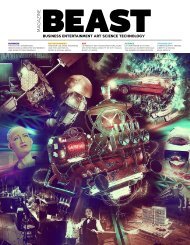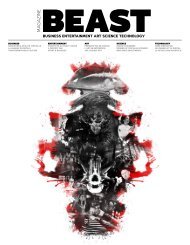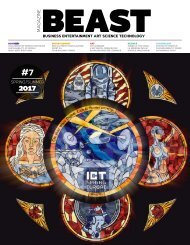Magazine BEAST #16 2019
Create successful ePaper yourself
Turn your PDF publications into a flip-book with our unique Google optimized e-Paper software.
#Business | Human Capital<br />
11<br />
Once they show how the initiative is managed and the results<br />
it starts to produce, others will increasingly welcome the<br />
initiative as it aims at supporting their employability.<br />
One might also say that upskilling programmes represent a<br />
considerable investment. Arguably, financial services seem to<br />
be overly positive about the future, as if stability was a shield<br />
to solve the challenges that technology and new customers’<br />
demands bring… I could tell this short story of a discussion<br />
between a CEO and a CFO with the latter challenging his/her<br />
boss about the costs of the upskilling action. First, the CFO<br />
goes: "We are going to invest a lot of money in our people skills<br />
but, what if they leave? The investment will be gone!". And the<br />
CEO answers: "Yes, but what if they stay and we don’t upskill<br />
them?"<br />
What are the main ingredients of an effective upskilling<br />
strategy? What are your main pieces of advice to the HR<br />
managers who would like to start working on such a strategy?<br />
CS: As usual, the secret lies in careful preparation. The process<br />
starts with the need to ask the right questions before even<br />
launching such a strategy: checking on stakeholders’ alignment,<br />
on management sponsoring, support of the employees’<br />
delegation, equipment of the HR department, availability of<br />
suitable training, etc. If those questions are not answered prior<br />
to starting, they will arise during the deployment and will slow<br />
the process down or even disturb it quite a bit.<br />
It also takes a good understanding of the "future of jobs" in the<br />
company. Nowadays the maximum time horizon to predict a job<br />
change is around a year. Understanding which ones will remain<br />
stable – the vast majority over one year –, which ones will be<br />
augmented or disappear, and finally which jobs will be created or<br />
replaced, due, for instance, to turnover or retirement, is a critical<br />
and difficult exercise for companies as from a certain size.<br />
Once this information is gathered, understanding current<br />
people skills – holistically, soft and hard skills – is the next step.<br />
Then comes the understanding of the capacity for an individual<br />
to perform augmented or new jobs. Naturally, this is related<br />
to individual skills but also to personal motivation as well. Most<br />
of the time, even if both are present, substantial training will<br />
be needed and the individual will need to commit to the effort.<br />
In return, the employer will secure a given job to the employee.<br />
The different steps require personal support and timely,<br />
purposeful communication is very important. If done at scale,<br />
it also requires some technology investment to perform all<br />
these processes smoothly. But, in the end, it is worth the effort!<br />
How would you define the current work environment?<br />
What about the addition of new technologies, and AI more<br />
specifically? How are they reshaping the workforce?<br />
Thierry Kremser: In our current digital world, the work<br />
environment is hyper-connected and data is virtually<br />
everywhere. Technologies are transforming the way we live<br />
and work: for instance, Artificial Intelligence and data analytics<br />
tools now offer techniques to turn data into information and<br />
information into insights. Our world has therefore become<br />
more data-driven than ever. Moreover, "data" is not just an ITrelated<br />
topic anymore. According to PwC’s 20 th CEO Survey,<br />
which explores the needs and expectations of almost 1,400<br />
CEOs from approximately 80 countries, 64% of CEOs believe<br />
that data management will differentiate their business in the<br />
future.<br />
<strong>BEAST</strong> MAGAZINE <strong>#16</strong>

















